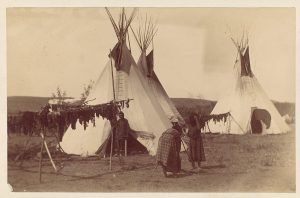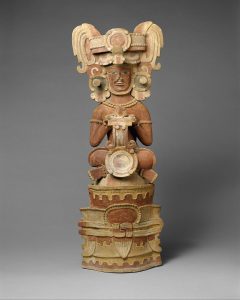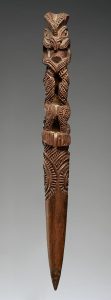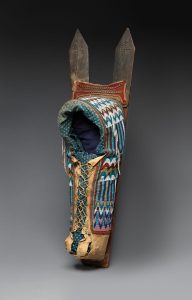9 Chapter 9: Art of the premodern Americas and Oceania
Maria Americo
Chapter 9: Art of the premodern Americas and Oceania
In this chapter, we’ll meet some artworks from the premodern cultures of the Americas and Oceania. Oceania is a region in the Pacific Ocean that includes over 10,000 islands, including Australia, New Zealand, and the Pacific Islands of Melanesia, Micronesia, and Polynesia. Let’s get to it.
Snow goggles
Alaska
800-1200 CE
-Image by the Metropolitan Museum of Art, used under a Creative Commons Zero (CC0) license, Public Domain
-Learn more about this art and find the image source here.
The function, use, and meaning of some ancient objects can be mysterious, at least from our perspective, when we lack the cultural context needed to interpret the significance of an object. Other objects speak to us clearly through the millennia, often because we still use, or at least we have seen, an object of similar type and similar function.
This is a pair of eye goggles from ancient times in what is today the US state of Alaska. They are made of walrus ivory, a traditional local material. They would have been used by the ancient wearer to protect their eyes from windblown ice and from the glare of the sun on pure, untouched white snow. (Spending a lot of time with the eyes unprotected in the snow can cause a condition called “snow blindness,” which is actually a form of sunburn on the eyes, from too much UV light reflected on a light-colored surface, such as snow.) The peoples of ancient Alaska would not have known any of our scientific or medical terms, like UV light or photokeratitis (the technical name for snow blindness). But generations of daily life in snowy landscapes taught them how to protect and care for themselves in their environment. We call this kind of experience-based wisdom indigenous knowledge.
Sometimes, students of ancient history here in the United States are surprised to learn that the US even has an ancient history. But it does—long, long before the age of Christopher Columbus, or European colonialism, settlement, and trade, or even the Vikings. There is evidence that people first migrated to what’s today the Americas more than 20,000 years ago.
Questions for reflection
- When you first looked at this object, did you know what it was, what it was used for?
- Describe this pair of eye goggles in detail. Do you see the designs and markings? What do they symbolize?
- Have you ever learned anything about the Americas during ancient times? If so, what? If not, why do you think this history isn’t taught?
- Have you ever learned a piece of indigenous knowledge or wisdom, perhaps from an elder family member?
Sources and further reading for this art
Credo Reference – snow blindness
Incense burner with seated king
Guatemala
300-400 CE
-Image by the Metropolitan Museum of Art, used under a Creative Commons Zero (CC0) license, Public Domain
-Learn more about this art and find the image source here.
This elaborately crafted ceramic incense burner was found in what’s today Guatemala, and was created by artisans of the Maya people, who lived in what we call Central America today. The Mayans are one of the most famous of the peoples of the ancient Americas.
The burning of incense during religious and spiritual rituals has been a tradition since ancient times, and still continues today, in many indigenous cultures all over the world. Local incense would have been made of tree resins, and, as in many ancient rituals involving the burning of incense, the smell and the drifting of the smoke would have facilitated communication between our world and the world of the deities and spirits.
Questions for reflection
- Describe all of the details of this incense burner.
- The figure depicted here has been described as a king. What about this figure looks “royal” or “kingly” to you?
- Imagine the ritual during which this incense burner would have been used.
- Do you know anything about the Mayans? Perhaps you have heard of the Mayan calendar?
Sources and further reading for this art
Arts of the Ancient Americas – The Metropolitan Museum of Art
Credo Reference – Mayan Civilization
Credo Reference – Mayan astronomy
Maori weaving peg
New Zealand
late 18th-early 19th century CE
-Image by the Metropolitan Museum of Art, used under a Creative Commons Zero (CC0) license, Public Domain
-Learn more about this art and find the image source here.
This weaving peg made by a Maori artist was also, in premodern times, a functional object, like the snow goggles we encountered earlier in this chapter. However, while goggles and eye protection are often used by all kinds of people today, weaving, and other methods of making clothing and textiles by hand, are not as popular today as they were in premodern cultures. But this Maori weaving peg is also both a functional object that served an everyday purpose, as well as an artistic, symbolic, and even ceremonial object.
As we have explored in earlier chapters, the weaving of clothing and other textiles in premodern times was an intimate and personal act, a home and family activity often carried out by women, and also a creative process. And for the Maori people of Oceania, as well as for some other ancient cultures, the act of weaving was also seen as a metaphor—as we weave garments, we are weaving ourselves into the fabric of our families and generations, and we are weaving ourselves into history and into the fabric of the universe.
Questions for reflection
- Describe all of the elaborate artistic details of this object. What do you see? What do you think it symbolizes or means?
- Do you see any elements of this object that point to its functional use, as a tool for weaving fabrics?
- Do you know anything about the history of ancient (or modern) Oceania? If so, what, and where did you learn it? If not, why do you think you have never learned about this part of the world before?
Sources and further reading for this art
Credo Reference – Māori philosophy
Cradleboard
Oklahoma (Kiowa people)
1875 CE
-Image by the Metropolitan Museum of Art, used under a Creative Commons Zero (CC0) license, Public Domain
-Learn more about this art and find the image source here.
This beautifully decorated cradleboard, made of leather and animal hide, was made by the women in a new mother’s family upon the birth of her baby. As we have already explored in this book, many objects of household daily life were made by, and used by, women. These everyday objects that blend function, art, and craftsmanship together represent one of the artistic legacies of women throughout history.
A cradleboard is a Native American object that allowed a baby to be part of their mother’s everyday tasks: a cradleboard could be attached to the mother’s saddle when she rode on horseback, propped up against her tipi (a traditional dwelling of many Native American cultures), or worn on the mother’s back—a method of baby-wearing that many mothers practice today, all over the world.
Questions for reflection
- Describe the shape and functional details of this object. Can you see how it was used?
- What color jumps out at you the most in this object’s color scheme? What mood or feeling does the color scheme evoke?
- Imagine the scene during which the Kiowa women created this object for one of their family members who had just given birth.
Sources and further reading for this art
Redefining American Art: Native American Art in The American Wing – The Metropolitan Museum of Art
5. 
Photograph of a Native American camp
Unknown location
1880s-1890s CE
-Image by the Metropolitan Museum of Art, used under a Creative Commons Zero (CC0) license, Public Domain
-Learn more about this art and find the image source here.
This is the “newest” or “most modern” style of art that we have encountered in this book together: it is an albumen silver print, an early method of producing photographs using egg whites (albumen means egg white).
The art of photography often carries a sense of being on the outside, looking in. Often, early American colonialists, settlers, and travelers would draw, photograph, or create written descriptions of the Native peoples that they encountered as they occupied more and more of what’s today the American continent. This photograph is one piece of artistic evidence of this process: the “capturing” of Native American culture in art by early American settlers, as these colonialists also “captured” land and other resources from their Native stewards.
This photograph also provides us evidence for 19th-century tipis made by Native cultures. Tipis have been used by North American Native cultures since at least 2000 BCE. Their construction varies across geographic space, but the basic tipi structure involves three or four poles, buried partially in the ground, supported by several other poles, and a covering of animal hide, sewn by Native women using animal sinew as thread.
Tipis still exist and are in use today, often as ceremonial or celebratory dwellings. And, of course, the art of photography is very much still in use today—in fact, it’s one of the most popular of the modern-day art styles, and is one that you have certainly come across before and will encounter again. There is no question that you have even participated in the artistic creation of photographs yourself—in other words, you have taken photos with your phone. Take our tools for looking at a photograph as art with you the next time you take, or see, a photo.
Questions for reflection
- All photographs reveal something about the person who took them as well as whatever is being photographed. (We call the person, place, or thing being photographed the “subject” of the photo.) What does this photograph reveal about the ideas or interests of the photographer? What does it reveal about its subject?
- Describe all the details of this photograph. What do you see? Where do you think this photo was taken?
- What mood or emotional sense does this photograph evoke? How did the photographer capture that mood, or how does the landscape inspire it?
- How can we learn about other cultures, especially native or indigenous cultures, in a respectful way, without perpetuating stereotypes, exoticism, or “othering”?
- What’s your favorite photograph that you’ve ever taken? When and where did you take it? What memories do you think of when you see it?
Sources and further reading for this art
Credo Reference – albumen print
Photographs – The Metropolitan Museum of Art
Native-Land.ca | Our home on native land (if you want to learn more about the Native cultures of the Americas, please check out this tool. As the Native Land’s main website page states, “Native Land Digital honors the sovereignty of all Indigenous nations, their lands, and their waters. We recognize that these boundaries and territories are representations of the sacred. We respect the rights of Indigenous data sovereignty, and we are committed to an ongoing process of collaboration, growth, and learning. We work to update and replace information that is a continuation of trauma caused by theft, injustice, misinformation, and ignorance.”)
Media Attributions
- Alaskan snow goggles
- Mayan incense burner
- Maori weaving peg
- Native American cradleboard
- Native American camp




